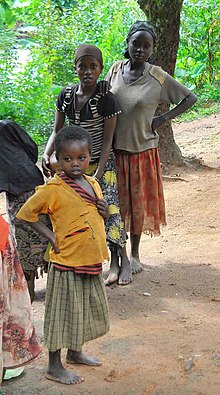Aari people

Aari or Ari are a tribal
History
Until the 19th century, Aari people lived under independent chiefdoms. The divine ruler of the Aari tribal societies were called baabi.
In the late 1800s, the
Society

Caste system
The Ari peoples of Ethiopia comрrise different occupational groups and their society is socially divided and
Religion
Most Aari follow either Protestant Christianity or traditional beliefs. A few practice Orthodox Christianity.[9]
After conquest by the Ethiopian Empire in the late 1800s, many Aari were forced to convert to Orthodox Christianity,[3] although this religion became heavily stigmatized due to its association with the invading forces and perceived economic exploitation by Orthodox priests.[10] In the 1950s, large numbers became Protestants as a result of Western missionary work (especially by SIM). Today, the vast majority of Aari Christians are Protestants.[10]
See also
References
- ^ "Ethiopian Census 2007". csa.gov.et. Addis Ababa: Ethiopian Central Statistics Agency. 2007. Archived from the original on 2011-07-28. Retrieved 9 July 2021.
- ^ "Aari". Ethnologue. Retrieved 2021-07-31.
- ^ S2CID 144473850.
- JSTOR 3774010.
- S2CID 225153643.
- doi:10.14989/173537.
- ISBN 978-019-882-1250, pages 219-223. Quote: "Today there is an intricate caste system that shapes the lives of many people within Ethiopia, with elaborate rules preventing marriage between groups with different traditional roles. The Ari include three subgroups--the Cultivators, Blacksmiths, and Potters--who are socially and genetically differentiated from one another and from non-Ari groups. Since the Ari have a distinctive genetic affinity to the forty-five-hundred-year-old ancient highland individual compared to other Ethiopian groups, it is clear that there were strong local barriers to gene exchange and homogenization within the region of present-day Ethiopia that persisted for at least forty-five hundred years. This is the best example of strong endogamy that I know of even more ancient than the evidence of endogamy in India that so far is only documented as going back a couple of thousand years."
- ISBN 978-4-431-55997-9.
- S2CID 153922382.
- ^ ISBN 978-3-8258-7792-7.
Further reading
- Alexander., Naty (1992). The culture of powerlessness and the spirit of rebellion among the Aari people of southwest Ethiopia : a dissertation. OCLC 1206449840.
- Gebre, Yntiso (2010-11-15). "Cultural contact and change in naming practices among the Aari of southwest Ethiopia". Journal of African Cultural Studies. 22 (2): 183–194. S2CID 153922382.
